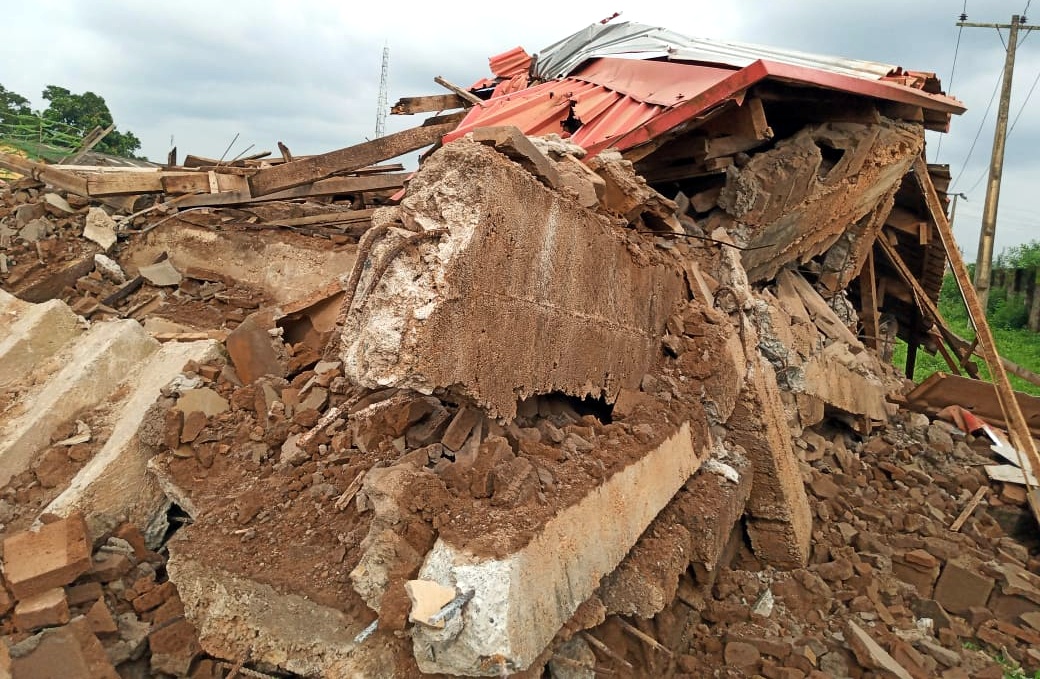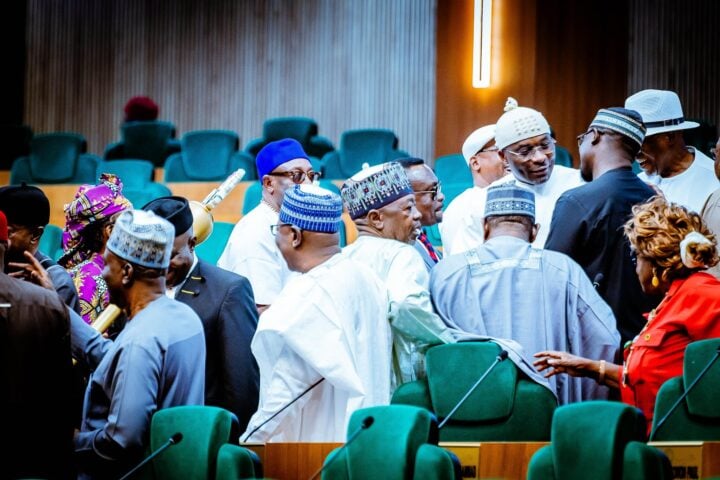Arts Interview: Guglielmo Castelli On His Debut at Mendes Wood DM | Observer

Composing a painting often requires a degree of staging: as in theater, characters enter and exit the scene, moving through a transitional narrative state that stretches across time and space, blending the tangible world with a more interior, psychological realm. Timed with São Paulo Art Week and marking his Brazil debut with a solo exhibition at Mendes Wood DM’s original Barra Funda location, Italian artist Guglielmo Castelli has, for the first time, translated his richly poetic universe into immersive scenography. The theatrical role-play of his layered painterly compositions spills into the gallery itself, which he has transformed into the stage for an allegorical pantomime of human existence.
According to Castelli, this exhibition marks a further evolution of the installation-based approach he began exploring with his major solo presentation during the most recent Venice Biennale, where he introduced several multimedia works. Already popular among Italian collectors, the artist has lately drawn a surge of international interest and attention, particularly after joining Mendes Wood DM’s roster in 2022. That move triggered a notable rise in his prices, which quickly shifted from the four to the five-digit range following a series of sold-out shows. Last October, his oil and acrylic on canvas Bite the Bullet (2021) realized £151,200 at Christie’s London, far exceeding its £60,000-80,000 estimate. The artist’s current record is $244,546, achieved by the large-scale oil on canvas Drunken Incantations (2020) at Sotheby’s London in March of 2023.

The new body of works created for the show installed in the São Paulo gallery space has been hung with generous breathing room between canvases, accompanied by sculptural maquettes and mixed-media pieces incorporating fabrics, collages and drawings. Playing with shifts in scale and perspective, this staging amplifies the panoramic, cinematic vision of his canvases while alluding to the scenographic multiverse that fuels his practice.
Castelli’s approach to figuration resists a single, linear reading: characterized by a singular dramatic “depth,” his paintings instead translate existential experience into a continuous negotiation between inner and outer realities. Delving into oneiric and imaginative terrain, he evokes the specters of fear, trauma and tragedy that surface in the layered folds of psychological, mnemonic and temporal space.
The result is a densely stratified pictorial field where figures dissolve into each other and their environments, immersed in fluid scenes that blur the edges of reality and imagination, subconscious and reason. “Mine is a narration understood in terms of time and space, and therefore it has a universality of subjects and stories in its own space where something can happen,” the artist tells Observer during a walkthrough of the exhibiton, describing how temporalities and references coagulate into a stream of recurring behaviors, myths, and patterns within the human condition. Archetypes emerge from this process, refracting personal experience through a symbolic lens.
Castelli didn’t study painting. Coming to it through drawing and theater, painting emerged out of the necessity to find a synthesis between media while embracing the fluidity required to realize his imagination’s potential fully. “The fact that it is impossible to trace its origins and has multiple layers, both technically and in terms of its reading, means that my painting practice is explicitly bound to other media, for example, ballet or performance,” he explains. With his background in set design, he continues to explore composition as a live act, experimenting with the meanings that surface through dialectics, juxtapositions, and asymmetries between elements. “I like to think of myself as the ‘prop master’ for my compositions.”

Operating within the realm of a Gesamtkunstwerk, Castelli is deeply European and even more profoundly Italian—an artist for whom, as in opera, artwork, design and narrative coalesce into a unified aesthetic and intellectual experience. “There is the aspect of theatricality in the moment before you stage something. I want to create this sense of expectation and suspension before something happens in that scene,” he says.
Literature often kicks off Castelli’s process. For this show, in dialogue with the context of Brazil, he turned to João Cabral de Melo Neto’s 1975 volume Museu de Tudo (Museum of Everything). “Reading this collection of poetry, I found one that begins with this sentence that became the title of the exhibition: ‘A single rooster does not weave a morning,'” he says. “It’s a wonderful image, in the sense that the notion of weaving implies both a horizontal and a vertical plane, warp and weft. This resonates with my practice—a single brushstroke cannot make the painting, but it’s more about an accumulation of layers of paint and realities.”
Several paintings in the show articulate this accumulation of sensation and reference, channeling Castelli’s encounter with Brazilian and South American culture—its atmospheres, chromatic energies and spatial poetics. One canvas, Pan de Queijo (2024), plunges into this vivid immersion: a self-portrait of disorientation in a crowded square, colonial façades glowing beneath an oversaturated orange sky. As in many of his works, perspective bends and slips, evoking the sensation of groundlessness in an aesthetic rupture from the fixed European lens through which he had long perceived the world. “This painting deals with this European idea of representation, and how I felt so European in the midst of this wonderful chaos of what was going on around me. This sunset was pure beauty.”

Castelli’s signature layering ultimately becomes a way to reflect the synchronicity and interdependence of diverse energies coexisting within a shared space. The miniature scenes painted on antique leather tambourines in Meia-dia (2024) are particularly illustrative of this, rendered in a distinctly Brazilian palette to depict a rural scene where humans appear deeply entwined with the lush vegetation and its inevitable cycles of birth, death and renewal.
Throughout the exhibition, more intimate motifs surface, blending Italian and Brazilian popular imagery in ways that resist the formal constraints of European art history. With this show, Castelli probes what he calls a “different seismography,” where disparate elements coexist on a flat plane. As he puts it, his paintings are like magma, in continuous alchemical motion.
At the same time, a certain longueur permeates the exhibition, a trace of melancholy that Castelli refers to as a form of nostalgia. “I think my paintings are somehow outside of time,” he explains. This nostalgia is both dissonant and deliberate—its chromatic acidities and structural deformations marked by a self-aware unease.
The fragmented, ghostly figures in his paintings, with their disarticulated limbs and depersonalized gestures, are caught in a cycle of embodiment and disembodiment, a constant translation of emotion and sensation into a shared visual language that gestures toward universality. “This fact of having this sense of becoming and the notion of corporeality fragmented into many units are actually the same,” he says, reflecting on how his paintings engage in a continuous attempt to embody and reify feeling and perception.

“The memory is a personal perceptual dimension of time. Memories adjust at a certain time, where they fade into one another, merge and blend to compensate. It has to be fluid,” Castelli says. “As with the good theatre, it’s about this shared space where who is receiving and the sender and what belongs to whom are just confused.”
The feeling Castelli evokes could be located somewhere between Brazilian (the untranslatable saudade, a more intimate, aching longing for someone or something once cherished and now lost) and the German sehnsucht (a more universal yearning, a haunting desire to grasp the mystery of the cosmos and find meaning in existence). It’s not far from the notion of melancholia explored by movements such as Romanticism or Decadentism during similarly charged moments of historical and cultural upheaval. “It is a nostalgia that perfectly fits a historical moment like ours, in which a speed is required that painting cannot have. It is a nostalgia that speaks of a difficulty in relating to one another.”
At the heart of Guglielmo Castelli’s work lies a philosophical, psychological, and existential inquiry into the challenge of relating to others, of giving shape to one’s inner world, and the friction of exposing that layered weave of sensations and thoughts to external reality.
Aligned with this inquiry, Castelli has constructed an arena where ephemeral choreographies of symbolic and allegorical figures painted across the floor drift in divergent directions. Inviting the viewer to traverse this scenography, the composition demands a constant recalibration of perspective—each shift revealing new meanings and narrative threads. The choreography staged within the gallery prompts a more heightened, conscious experience of vision. Ultimately, Castelli’s aim is to mirror the layered, multidimensional nature of reality—an appeal to pluralism, to coexistence, to a continuous renegotiation of our position in the cosmos.












:strip_icc()/i.s3.glbimg.com/v1/AUTH_19863d4200d245c3a2ff5b383f548bb6/internal_photos/bs/2025/A/3/VzKLR7SKGd1Pf8pLDHwg/bruna.jpg)